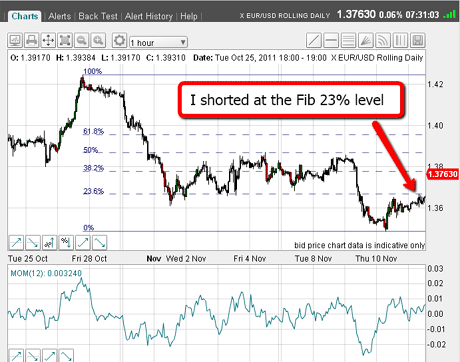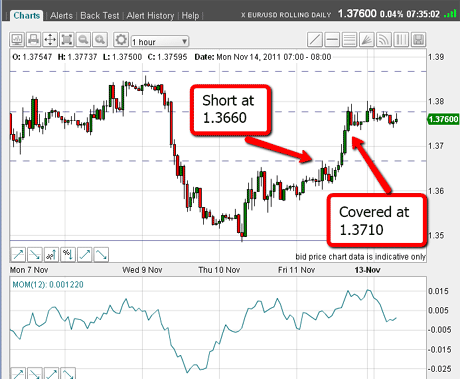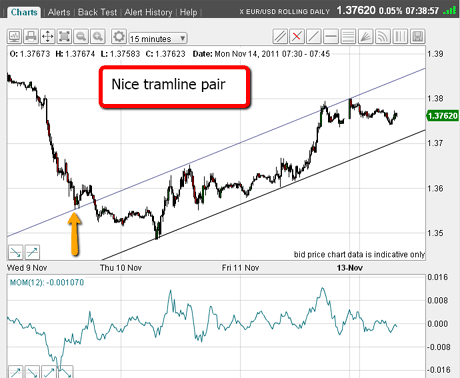The importance of money management - my euro trade goes wrong
John C Burford stresses the need to always use sound money-management principles, as graphically illustrated by a recent trade in the euro which went wrong.
On Friday, I noted that the rally in the euro against the US dollar was moving into significant overhead chart resistance.

(Click on the chart for a larger version)
I was looking for a place to short again, following my previously successful short trade earlier in the week.
MoneyWeek
Subscribe to MoneyWeek today and get your first six magazine issues absolutely FREE

Sign up to Money Morning
Don't miss the latest investment and personal finances news, market analysis, plus money-saving tips with our free twice-daily newsletter
Don't miss the latest investment and personal finances news, market analysis, plus money-saving tips with our free twice-daily newsletter
And in fact, I did make a short sale at the Fibonacci 23% level at 1.3660 on Friday. Because I was alert to the very real possibility that the rally could well continue further, I decided to enter a close protective stop at 1.3710.
I was right to be wary. The trade was not a success, as I will show!
Learning from past mistakes
Why was I especially unsure of this particular trade? There were several reasons:
The rally had only carried to a relatively short 23% retrace. Reversals from this level do occur, but in my experience, while I was willing to give it the benefit of the doubt on this occasion, deeper retracements are more common.
The rally had only carried to the underside of the congestion zone. More often than not, rallies carry a bit further into these zones.
Crucially, sentiment against the euro had reached fever-pitch last week, so a vigorous shaking of the tree was required to squeeze the new shorts. A strong rally was a distinct possibility.
After entering my trade, the market rallied to take me out at my stop at 1.3710 for a 50-pip loss. This was well within my 3% maximum loss limit.

(Click on the chart for a larger version)
OK, I know, this was not a great trade! In my defence, I believe all traders make them the fewer the better, of course.
In hindsight, I should not have put it on, as the odds were not overwhelmingly in my favour.
All traders have weaknesses - one of mine is to enter a trade prematurely (this is a good example). I have to fight this tendency all the time!
But this trade does graphically illustrate the benefit of always using a sound money-management principle.
If you take anything from this, I hope you agree that you will always use a solid stop-loss regime in your trading.
What next for the euro?
OK, so where are we this morning? Here is the latest chart:

(Click on the chart for a larger version)
The rally from Thursday's low can be contained in my lovely tramline pair. I like the upper one, anchored as it is by my pivot point, marked by the yellow arrow.
If you need to review why such pivot points are significant, see my video tutorials on tramline trading.
Over the weekend, the market has made a new high right to my upper tramline.
It has at the same time hit the next Fibonacci level, the 38% retrace at 1.3780.
Will this level be the final turning point for the relief rally?
For one thing, the market has eaten further into the overhead congestion zone, but on weak momentum.
To review how I use momentum in my trading, see my latest video tutorial.
As I write, the market is backing off this morning's high and heading for my lower tramline.
A break through this tramline would be bearish, I believe, and short sales could be made in this event.
Keep a close eye on your positions
But as I have noted before, because of high volatility, I am trading lightly. This is not the time to be taking long-term positions. We have seen what has happened to traders/investors who like to buy-and-hold.
As one measure, the S&P is at the same level it was seven years ago, and the euro is at the same level it was in 2004!
If anyone had bought or sold the euro back then, they would not only be very frustrated, but without a profit (or loss). But just look at the huge profitable swings they missed since then.
Traders who are successful actively manage their positions and never put them away in a drawer! This applies in spades to leveraged instruments, such as in spread betting.
If you are new to trading, one thing you must do early on is to decide on the timeframe you are most comfortable working in, be it day-trading, swing-trading, or longer-term position trading.
It's not an easy decision to make, but my advice would be to start short-term and keep a frequent watch on your positions and be willing to take profits quickly (based on chart signals, such as the indicators I show).
If you're a new reader, or need a reminder about some of the methods I refer to in my trades, then do have a look at my introductory videos:
The essentials of tramline trading
An introduction to Elliott wave theory
Don't miss my next trading insight. To receive all my spread betting blog posts by email, as soon as I've written them, just sign up here .
Get the latest financial news, insights and expert analysis from our award-winning MoneyWeek team, to help you understand what really matters when it comes to your finances.
John is is a British-born lapsed PhD physicist, who previously worked for Nasa on the Mars exploration team. He is a former commodity trading advisor with the US Commodities Futures Trading Commission, and worked in a boutique futures house in California in the 1980s.
He was a partner in one of the first futures newsletter advisory services, based in Washington DC, specialising in pork bellies and currencies. John is primarily a chart-reading trader, having cut his trading teeth in the days before PCs.
As well as his work in the financial world, he has launched, run and sold several 'real' businesses producing 'real' products.
-
 How cancelling unused direct debits could boost your pension by £37,000
How cancelling unused direct debits could boost your pension by £37,000A new year refresh of your spending could save you money and help boost your pension pot.
-
 NS&I cuts interest rates on 8 savings accounts
NS&I cuts interest rates on 8 savings accountsNS&I will now offer less attractive interest rates for customers wishing to lock their savings away to grow for one, two, three or five years.